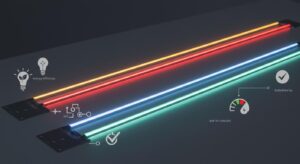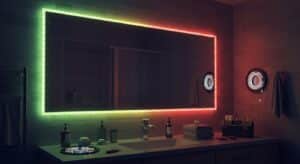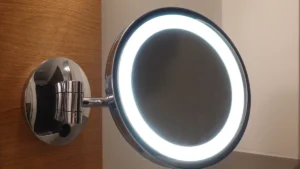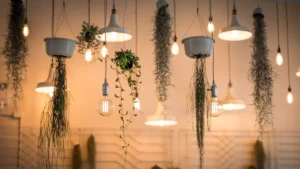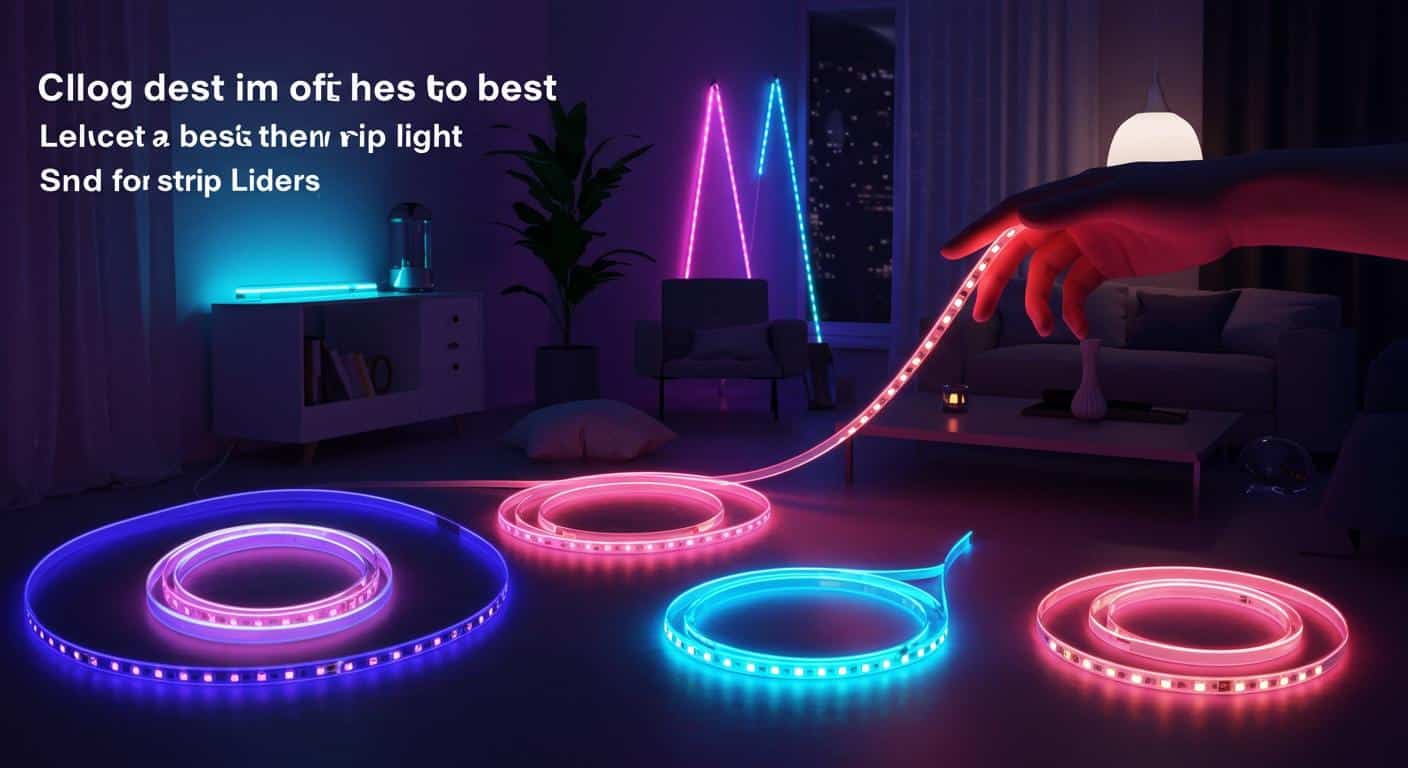
LED strip lights neon are very popular now. They are a top choice for homes and businesses. You can use them in many ways. They work well for decoration, signs, and lighting events. Picking the right LED strip lights neon is important. It helps you get the look and function you want. When you look at options, think about brightness. Also, consider color choices and how you plan to use them. This will help you find what fits your needs best.
Key Takeaways
Think about brightness measured in lumens when picking LED strip lights. More lumens give better light for tasks. Fewer lumens are good for creating a mood.
Decide between single-color and multi-color LED strips based on what you need. Single-color strips save energy and are good for steady lighting. Multi-color strips are flexible for events.
Know how important IP ratings are for outdoor use. A higher IP rating means your lights can handle bad weather, making them last longer.
Figure out why you need your LED strip lights. Whether for decoration or practical use, knowing the purpose helps you choose the right kind.
Plan your installation carefully. Measure your area, pick the right tools, and follow safety rules to make sure it goes well.
Brightness
Measuring Lumens
When you choose LED strip lights neon, knowing about brightness is very important. The brightness is measured in lumens. More lumens mean brighter lights. This can really help you see better in your area. Here’s a quick look at lumen output for different LED strips:
Type of LED Strip | Lumen Output Range (lumens/meter) |
|---|---|
Standard Flexible LED Strips | 250 to 500 |
High-efficacy Flexible LED Strips | 1000 to 2000 or more |
Picking the right brightness depends on what you need. For example, if you want lights for mood or accent, lower lumens might be better. But for task lighting, you need higher lumens for good visibility.
Choosing Light Intensity
Choosing the right light intensity for your LED strip lights can improve how your space looks and works. Think about these tips based on how you plan to use them:
For soft accent lighting, pick strips with 200-400 lumens per meter.
For good task lighting, choose strips with 600-800 lumens per meter.
Under cabinet lights need more lumens for visibility. Mood lighting behind a TV or in hallways can use lower-lumen strips.
Here’s a table that shows recommended lumen ranges for different places:
Environment | Lumen Range (lm/m) |
|---|---|
Mood/Accent Lighting | 510-1150 |
Cabinet Lighting | 570-1700 |
Task Lighting (close) | 910-1430 |
Task Lighting (away) | 1120-2250 |
Indirect Lighting | 1230-1840 |
Commercial/Industrial | 1640-3220 |
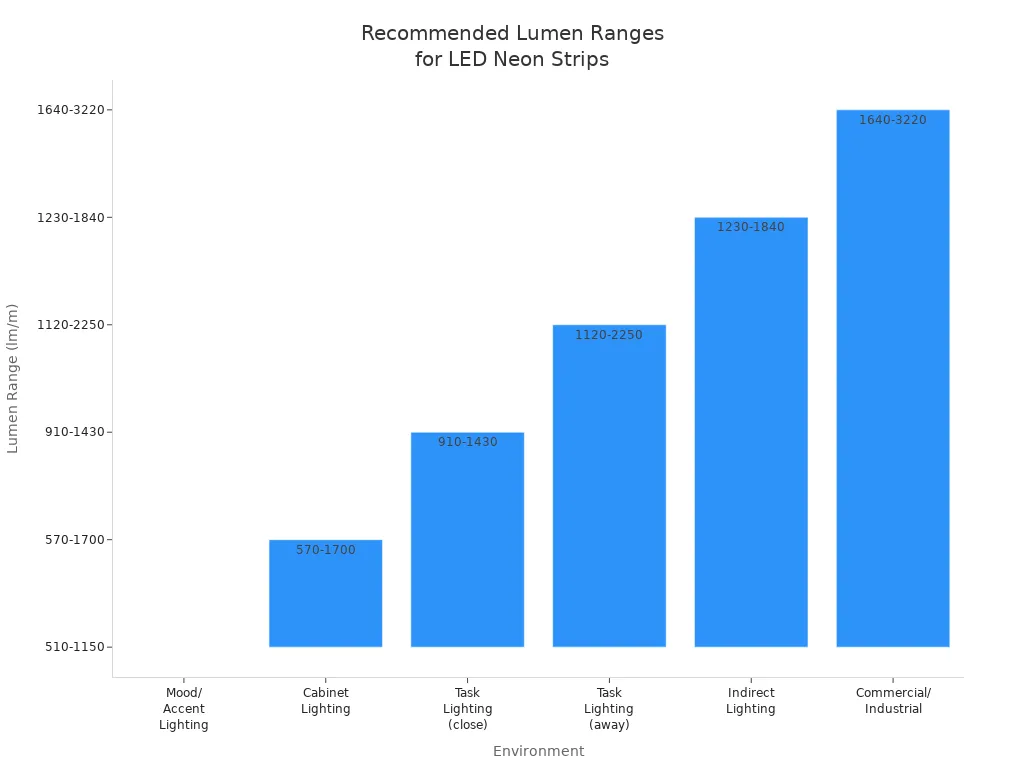
Always match the brightness of the LED strip lights with what you need for the space. This way, you can get the right effect, whether for mood or function.
Color Options for LED Strip Lights Neon
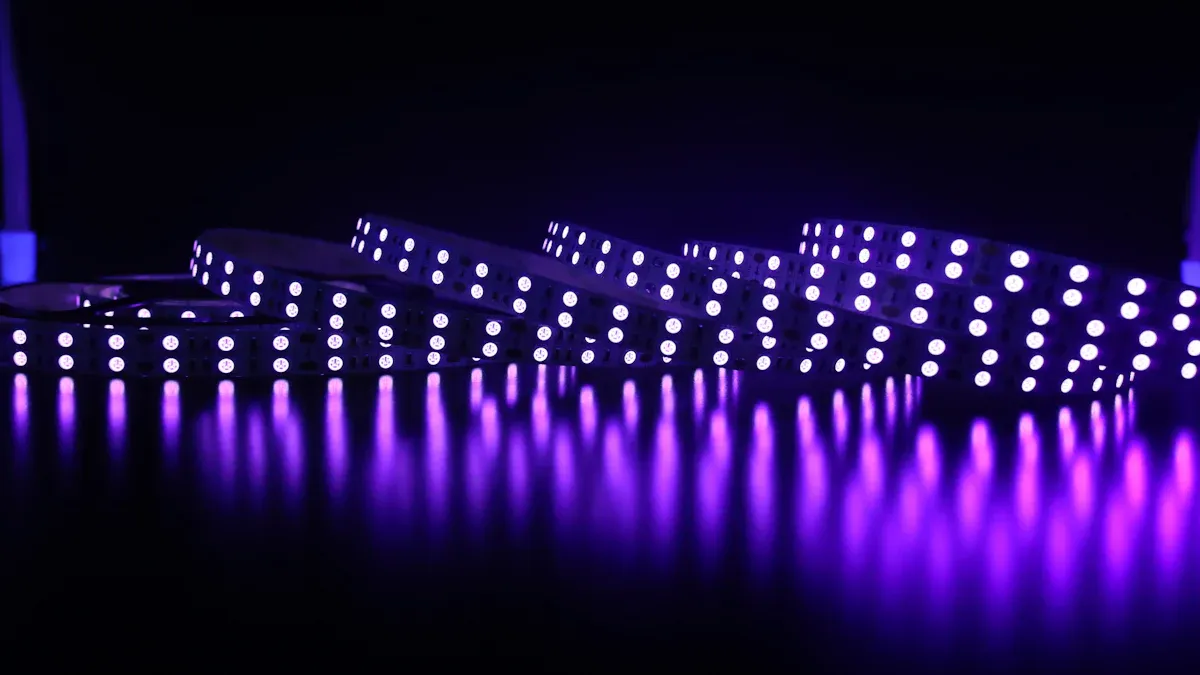
When you choose LED strip lights neon, you have two main types: single-color and multi-color strips. Each type has special features that can change how your lights look.
Single vs. Multi-Color
Single-color LED strips shine in one color. This makes them great for steady lighting. You can use them for accent lighting, safety lighting, or to make your home feel warm and cozy. They usually use less energy and cost less.
Multi-color LED strips, called RGB (Red, Green, Blue) strips, can show many colors. This lets you create fun effects and change your lights for different events. But, they need special controllers to mix colors and set them up, which can make them more complicated and expensive.
Here’s a comparison of the two types:
Feature/Aspect | Single-Color LED Strips | RGB LED Strips |
|---|---|---|
Color Capability | Emits light in one specific color. Ideal for consistent lighting. | Can produce many colors. Great for fun effects. |
Control and Programming | Easy control, usually just on/off or dimmer. | Needs special controllers for mixing colors. |
Energy Consumption | Usually uses less energy. | Uses more energy but can be efficient compared to older lights. |
Durability | Weather-resistant, simpler design. | More parts may make them a bit less durable. |
Cost | Cheaper because of simpler design. | More expensive due to advanced technology. |
Application Scenarios | Accent lighting, safety lighting, mood lighting. | Commercial displays, holiday decorations, entertainment venues. |
Color Temperature
Color temperature is also important when picking LED strip lights neon. It shows the color of the light, measured in Kelvin (K). Different color temperatures change the feel of your space.
For example, a lower color temperature (around 3000K) gives a warm, cozy feel, great for living rooms or bedrooms. A higher color temperature (5000K and above) gives a cool, bright light, perfect for work areas or places needing good visibility.
Choosing the right color temperature can change the mood of your space. Here are some common color temperatures and where to use them:
Color Temperature | Description | Applications |
|---|---|---|
3000K | Warm and cozy lighting | Great for living rooms and bedrooms |
4000K | Natural and bright lighting | Good for many home and business spaces |
5000K | Bright and clear lighting | Best for work areas and places needing good visibility |
By knowing the differences between single-color and multi-color LED strips, and understanding color temperature, you can make a lighting plan that fits your space. Whether you want a warm and cozy feel or a cool and modern look, the right choices will improve your environment.
Determine the Purpose of the LED Strip Lights
When you pick LED strip lights, knowing their purpose is very important. What you plan to use them for will affect your choice. You can think about two main areas: indoor vs. outdoor use and decorative vs. functional lighting.
Indoor vs. Outdoor Use
The place where you put your LED strip lights matters for how long they last and how well they work. For outdoor use, you need lights with a higher IP rating. This helps them handle bad weather. Here’s a quick look:
Environment | Protection Level | Description |
|---|---|---|
Outdoor | IP65 or higher | Dustproof and can handle light water flow. |
Outdoor (special) | IP67 or IP68 | Can survive being in water or high humidity. |
Indoor | IP20 | Stops finger contact but is not waterproof, good for dry places. |
For outdoor lights, make sure they can resist weather and UV rays to avoid fading. Indoor lights can focus more on looks since they don’t deal with the same weather issues.
Decorative vs. Functional Lighting
Next, think about if you need decorative or functional lighting. Each type of LED strip lights has different uses. Here’s how they are different:
Purpose | Die led-landing | LED Neon Lights |
|---|---|---|
Under-Cabinet Lighting | Great for focused and adjustable light | Not good for detailed tasks |
Accent Lighting | Highlights features and adds decoration | Gives a steady glow for decoration |
Task-Oriented Lighting | Good for areas needing bright and steady light | Not as good for task needs |
Decorative lighting makes your space feel better. You can use it to add interest or set a mood. Functional lighting is about giving enough light for tasks.
By knowing how to figure out the purpose of the LED strip lights, you can make smart choices that improve both how your space looks and how it works.
IP Rating
Understanding IP Ratings
An IP rating stands for Ingress Protection rating. It shows how well an electrical box keeps out dirt and water. This rating has two numbers. The first number shows protection from solid things. The second number shows protection from liquids. Knowing these ratings is very important when picking LED strip lights for different places, especially outside.
Choosing the Right IP Rating
If you want to put LED neon lights outside, a high IP rating is very important. It makes sure your lights can handle water and dust. Here are some important points to think about:
A high IP rating keeps out water and dust. This is key for outdoor or wet places.
IP67 stops dust and protects against short water exposure.
IP68 is completely dustproof and waterproof. It works well for long time in water.
IP69 is made for high-pressure cleaning. It stays strong in tough conditions.
To help you pick the right IP rating, here’s a table of common ratings and where they work best:
IP Rating | Description | Suitable Environments |
|---|---|---|
IP20 | Not waterproof. For dry indoor places only. | Indoor use only |
IP65 | Dustproof, some protection against water splashes from any side. | Covered outdoor areas, indoors |
IP67 | Dustproof and waterproof, good for wet places, but not for full immersion. | Wet indoor and outdoor places |
IP68 | Dustproof, waterproof, and can be fully submerged. | Underwater uses like pools and aquariums |
Think about where you will put your LED strip lights. For example, if you want to use them outside, in bathrooms, or near pools, make sure they have the right IP rating. This will help you avoid problems with water damage and make your lights last longer.
Buying LED Neon Flex
When you think about buying LED neon flex, there are a few important things to consider. Two key factors are temperature resistance and the Color Rendering Index (CRI).
Temperature Resistance
Temperature resistance is very important for how well LED neon flex works and how long it lasts. Different materials can handle different temperature ranges. Here’s a quick comparison:
Material Type | Temperature Range | Key Features |
|---|---|---|
Silicone | -40°C to 60°C | Very flexible, resists UV light, great water protection (IP67/IP68) |
PVC | -15°C to 60°C | Cheaper, good moisture protection (IP65), not as flexible as silicone |
Choosing the right material helps your LED neon lights last in your area’s climate. For example, silicone is more flexible and durable in extreme temperatures. This makes it great for outdoor use where the weather can change a lot.
Color Rendering Index
The Color Rendering Index (CRI) is important when picking LED neon flex for showing colors accurately. A higher CRI means better color accuracy, which is important in places like art galleries or stores. Here are some key points about CRI:
Choose CRI ≥ 90 for bright color display.
Good quality LED neon flex usually lasts between 30,000 and 50,000 hours, which is about 10 to 17 years if used for 8 hours a day.
High CRI lighting makes products look better, attracting more customers.
By knowing about temperature resistance and CRI, you can make smart choices when buying LED neon flex. These factors affect how good your lighting looks and how well it works in different places.
Installation Tips
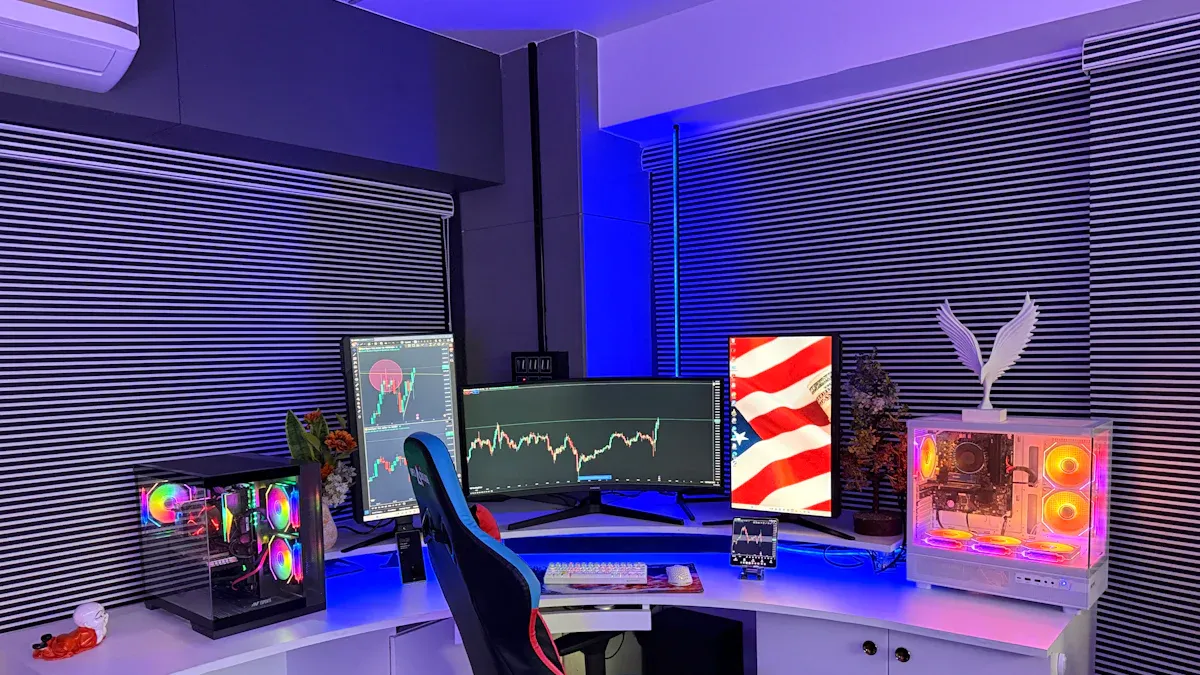
When you want to install LED neon lights, you have two main choices: do it yourself (DIY) or hire professionals. Each choice has good and bad points.
DIY Installation
Choosing DIY installation can be fun. You save money and can change your lighting how you want. But it can also be hard. Here’s a quick look at DIY and professional installation:
Installation Type | Advantages | Disadvantages |
|---|---|---|
DIY Installation | – Cost-Effective: Saves money. | – Complexity: Can be tough for tricky designs. |
– Flexibility: Easy setup and changes. | – Risk of Damage: You might break things without help. | |
– Customization: Make your lighting unique. | – Lack of Expertise: Results may not be the same every time. | |
Professional Installation | – Expertise: Experts do the job well. | – Higher Costs: More expensive because of labor and tools. |
– Longevity: Made to last with strong materials. | – Time Investment: Can take a long time for big jobs. | |
– Professional Finish: Looks neat and nice. | – Dependence on Experts: You need experts for complicated projects. |
If you decide to do it yourself, make sure you have the right tools and materials for a safe and good installation. Here’s a list of important items you’ll need:
LED Neon Strip Lights
Power Adapter/Transformer
Connector Wires
Double-sided tape or mounting clips
Measuring Tape
Scissors or a cutting tool
Clean rag
Drill and Screws (optional)
Level or Laser Level
Before cutting the neon strips, measure the area carefully. This makes sure the length fits just right. Cutting too long or too short can waste materials or cause uneven lighting. Also, check that the power supply matches the voltage needs of the neon strip lights and can handle the total wattage if you use more than one strip.
Tools Needed
Using the right tools makes your installation easier. Here’s a quick list of tools you should have ready:
Measuring Tape: For measuring the area where you will install.
Scissors or Cutting Tool: To cut the LED strip lights to the right length.
Screwdriver: For putting in any mounting clips or brackets.
Clean Rag: To clean surfaces before you start.
Avoid common mistakes during installation to make sure it goes well. Here are some things to watch out for:
Choosing the Wrong Type of LED Strip Lighting
Using the Wrong Power Supply
Forgetting to Use Proper Connectors
Not Measuring Correctly
Cutting LED Strip Lighting Wrong
Not Mounting LED Strip Lighting Well
Ignoring Environmental Factors
Overlooking Dimming and Control Options
Skimping on Quality Accessories
Not Asking for Help When Needed
By following these tips and being careful with your tools, you can successfully install your LED strip lights.
To sum up, picking the right LED strip lights neon has some important things to think about. You need to look at brightness, color choices, purpose, IP ratings, and how to install them. Each part is important for creating the right feel in your space.
When you decide, remember these tips:
Pick good quality LEDs for better brightness and longer life.
Think about RGB options for fun lighting.
Make sure to get a high IP rating for outdoor use.
Measure your area and find cutting points.
Match the voltage with your power supply to save energy.
By making smart choices, you can improve your space and enjoy your lights for a long time. Choosing energy-efficient LED neon lights helps lower your electricity bills and is good for the planet.
FAQ
What are LED neon lights?
LED neon lights are flexible lighting strips that mimic traditional neon lights. They use energy-efficient LED technology, providing vibrant colors and various applications for decoration and signage.
How do I install LED neon strip lights?
You can install LED neon strip lights using adhesive backing or mounting clips. Ensure you clean the surface before applying. Follow the manufacturer’s instructions for connecting to power sources.
Can I cut LED neon strip lights?
Yes, you can cut LED neon strip lights at designated points marked on the strip. This allows you to customize the length to fit your space perfectly.
Are LED neon lights safe for outdoor use?
Yes, many LED neon lights are safe for outdoor use. Look for products with a high IP rating, such as IP65 or higher, to ensure they withstand weather conditions.
How long do LED neon lights last?
LED neon lights typically last between 30,000 to 50,000 hours. This longevity makes them a cost-effective choice for both decorative and functional lighting.
See Also
Selecting The Perfect LED Strip Lights For Your Space
Essential Advice For Picking The Best Neon Rope Lights
Five Key Tips For Selecting The Best LED Strip Lights
